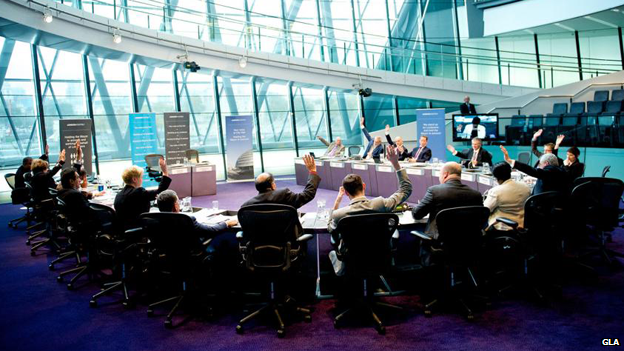How the London election works
- Published
On 5 May 2016 Londoners go to the polls to elect a mayor and 25 members of the London Assembly.
The mayor and the London Assembly make up the Greater London Authority (GLA).

The London Assembly is based at City Hall, near Tower Bridge.
What does the London mayor do?
Transport, policing, environment, and housing and planning in London are the four big areas which the mayor controls.
The mayor also creates policies for arts and culture, business, fire, health, regeneration, sport and young people in London.
What does the London Assembly do?
The London Assembly debates the mayor's policies,
The assembly must also be consulted over the GLA budget. It can reject mayoral policies or amend the draft budget if two-thirds of assembly members agree to do so.
How to vote
Polling stations are open from 0700 until 2200 on 5 May.
Registered voters will be given three ballot papers - pink, yellow and orange.
After polls close, ballot boxes are stored overnight and counting begins from 0900 on Friday.
Results are expected on Friday evening.
Voting for the mayor
Using the pink ballot paper, voters choose their first and second preferences for mayor.
The votes are counted and if a candidate has won more than 50% of first preferences, they are elected mayor.
If no candidate has won more than 50%, all but the top two candidates are eliminated.
Any second preferences for the top two candidates from the eliminated candidates are added to their totals. Whoever has the most votes combined is declared the winner.
Second preferences on the ballot papers of the top two candidates for one of the other top candidates are not counted.
Voting for the London Assembly
Voters have two ballot papers to choose the two types of London Assembly member.
The yellow ballot paper is used to choose the constituency member. Voters choose one candidate, who if elected will represent their area of London.
Ballots are counted and whoever has won the most is elected.
The orange ballot paper is used to choose one of the 11 additional London-wide assembly members, who represent the whole city.
This time, voters choose one political party or an individual standing as an independent candidate.
London-wide seats are allocated using proportional representation, using a mathematical formula called modified D'Hondt.